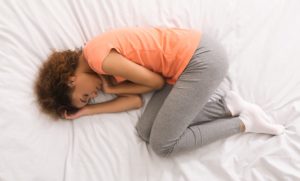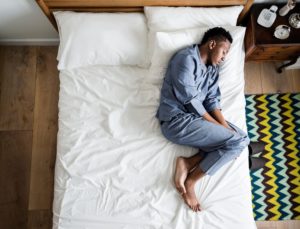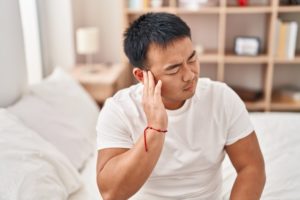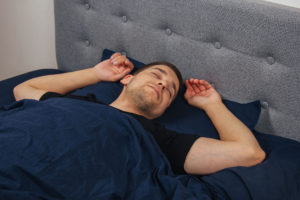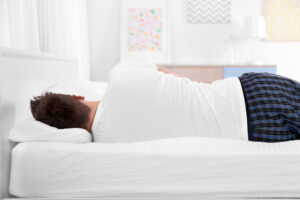When you buy through our links, we may earn a commission. Products or services may be offered by an affiliated entity. Learn more.
Side Sleeping: Which Side Should You Sleep On?
- The best side to sleep on depends on your personal preference, as well as the support of your mattress and pillow.
- Left-side sleeping may benefit pregnant people or those who experience acid reflux.
- Right-side sleeping may be preferred by people with heart conditions.
- Side sleeping can potentially help relieve pain, reduce the risk of snoring and sleep apnea, and improve overall health.
Not only is side sleeping preferred by most adults, but it’s also considered to be one of the healthiest sleep positions. Side sleeping offers many benefits, from improved spinal alignment to a reduced risk of snoring.
To unlock the full potential of these benefits, however, you need to get into just the right position. Learn more about how to sleep on your side, which side you should sleep on, and what else to consider.
Is Your Troubled Sleep a Health Risk?
A variety of issues can cause problems sleeping. Answer three questions to understand if it’s a concern you should worry about.
The Best Side to Sleep On
For most people, there’s no significant difference between right-side sleeping versus left-side sleeping. Both positions can support proper spinal alignment, provided you have the right pillow and mattress.
That said, sleeping on one specific side might be better for people with specific health concerns, such as those who are pregnant or those with heartburn, shoulder pain, or heart conditions.
- During Pregnancy: As pregnancy progresses, experts strongly recommend sleeping on the left side. While occasional right-side sleeping is fine, experts caution against sleeping on your back during the second and third trimester.
- If You Experience Heartburn: Experts usually recommend elevating the head of the bed if you have heartburn. However, there’s also evidence that left-side sleeping may help curb acid reflux symptoms.
- Those With Heart Conditions: People with heart failure sometimes find they experience shortness of breath when lying on their left side but not on their right side.
- If You Have Shoulder Pain: People with shoulder pain may find themselves naturally sleeping on the pain-free side.
Benefits of Sleeping on Your Side
Both right- and left-side sleeping may have benefits for spinal alignment, breathing, and brain functioning.
Neck and Back Pain Relief
Many people live with chronic neck or back pain. Research suggests side sleeping, particularly symmetrical side lying, can reduce pain in the back and neck.
However, the best sleeping position for back and neck pain may vary depending on your specific symptoms. Back sleeping may or may not help reduce lower back pain, while stomach sleeping is generally considered to increase the amount of pressure on your spine and lead to pain upon waking.
Reduced Risk of Snoring and Sleep Apnea
People tend to snore more when sleeping on their backs instead of their sides. When you sleep on your back, it’s easier for your tongue to fall back into your throat, creating an obstruction that can result in snoring.
When you sleep on your side, your airway may stay more open, so you can breathe easier. For this reason, physicians recommend people with position-dependent sleep apnea, a sleep-related breathing disorder, sleep on their side to help relieve symptoms.
Additionally, symptoms of central sleep apnea — a type of sleep apnea that often accompanies heart failure — are much better when sleeping on either the left or the right side rather than the back.
Healthier Pregnancy
Side sleeping is recommended for pregnant people , because it’s easier for the heart to pump blood through the body in this position. Side sleeping also prevents the baby from putting too much pressure on the vena cava, the largest vein in the body. And left-side sleeping, in particular, exerts less pressure on the liver and increases blood flow to the fetus and kidneys.
Side sleeping is considered safer during pregnancy, since back sleeping is associated with an increased risk of late stillbirth in some studies. It may also help prevent or relieve pregnancy-associated back pain.
Decreased Risk of Heartburn
Sometimes called acid reflux, heartburn occurs when the esophagus opens and allows partially digested food and stomach acid to move back up the esophagus. This causes an acidic burning sensation or pressure in the chest. People who regularly experience these symptoms may be diagnosed with gastroesophageal reflux disorder (GERD).
Sleeping on the left side keeps the esophagus positioned slightly higher than the stomach, which encourages digested food to continue moving through the digestive tract instead of backing up into the esophagus.
Potentially Improved Brain Health
During deep sleep, the brain’s glymphatic system flushes out toxic waste products. These waste products build up throughout the day as a by-product of metabolism, and a failure to properly clear them out is linked to the development of neurodegenerative diseases.
Animal studies suggest that side lying is the best position for glymphatic functioning , though human studies are needed to confirm this finding.
Tips for Side Sleeping
Your sleep position is just one part of the overall sleep setup. You can get the most out of side sleeping if you choose the right mattress and pillows and make some tweaks to the exact side sleeping position.
Get Into a Symmetrical Side Sleeping Position
Symmetrical side sleeping supports the natural curvature of your spine and may be less likely to cause back and neck pain.
- Lie on your side with your head on the pillow.
- Ensure your chin and neck are aligned in the center of your shoulders, and your shoulders are in line with your hips.
- Keep your head looking forward, so your chin doesn’t tilt down to your neck or twist to the side.
- Keep your arms and hands aligned with each other, either by your sides or slightly in front of you.
Many side sleepers opt for a fetal position, with their legs bent and curled in toward their chest. This position can relieve pressure in the lower back and is often preferred by people with chronic lumbar pain.
Pick a Mattress That Supports Side Sleeping
The best mattresses for side sleepers tend to be medium or medium firm, a 5 or 6 on a scale of 1 to 10 with 10 being the firmest. These mattresses cushion hips and shoulders while maintaining spinal alignment.
Your mattress and pillow should evenly distribute your weight while supporting a neutral position for your neck and torso. The right mattress for you depends on factors like your body shape, your weight in addition to your typical sleep position.
For side sleepers, mattresses that are too soft may fail to support weight-bearing areas like the hips, allowing them to sink in too far and pull the spine out of alignment. Mattresses that are too firm don’t provide enough cushioning. Not only can this cause sore hips and shoulders, but it can also allow a gap to form between your waist and the mattress surface. If your abdomen sinks down to fill this space, it can also lead to discomfort and spinal misalignment.
Get a Pillow Designed for Side Sleepers
A supportive pillow reduces strain on the neck and plays an important role in preventing neck pain. Ideally, the pillow should fill in the space between your head and the mattress to keep your head aligned on an even plane with your spine. Since the shoulders raise the head further from the bed when side sleeping, side sleepers usually do best with a thicker pillow.
An unsupportive pillow may cause morning aches and pains, or even headaches. Firmer materials like latex are considered more effective at providing neck support, although the most important factors are the pillow’s shape and height, or “loft.” Using a supportive pillow can also keep weight off the shoulders to reduce pressure buildup if you have shoulder pain.
If you struggle to find a supportive pillow, you may prefer a cervical pillow, which has a higher part to support the neck and a lower loft under the head. Studies on back sleepers suggest this design helps keep the head and neck at approximately the same natural angle as they would be when you are standing up.
Consider Using a Knee Pillow
One major problem with side sleeping is that the upper leg — the one furthest from the bed — collapses onto the lower leg and causes the spine to twist. Placing a small pillow or a rolled-up towel between your knees can help relieve pressure on the hips and prevent your knees from collapsing onto each other. Placing your arms and legs strategically can also help stabilize you when side sleeping.
Pregnant people may find it helpful to place an additional pillow in the small of the back or under the abdomen or use a full-body pillow.
When to Consider a Different Sleeping Position
Side sleeping has benefits, but it’s not for everyone. People with chronic pain or aesthetic concerns may prefer back sleeping. If you’re unsure what sleeping position is best for your medical issues, talk to your doctor.
- You Have Sore Shoulders or Sore Hips: When lying on your side, the shoulders and hips bear the brunt of your weight where you contact the mattress, causing pressure points and potentially exacerbating pre-existing shoulder or hip pain. If you’ve tried a softer mattress with no improvement, you may find it more comfortable to sleep on your other side or try back sleeping.
- You Live With Back or Neck Pain: While the ultimate goal is to keep the spine on an even plan, the best sleeping position for back and neck pain can vary from person to person. While some people are comfortable side sleeping, others find it more comfortable to roll onto their back, sometimes with a thin pillow under the lumbar area. Experts do generally recommend against stomach sleeping, which is hard on the spine.
- You’re Concerned About Wrinkles: Sleeping on your stomach or side with your face pressed into the pillow can compress and stress your skin, leading to wrinkles . If you’re worried about wrinkles, sleeping on your back allows you to reduce this wrinkle-causing pressure.
If you switch from side to back sleeping, a thinner pillow may help support your new sleep position. Look for a medium-loft pillow that’s high enough to provide cushioning for the neck when back sleeping but not so high that it causes your chin to tilt forward into the chest.

Still have questions? Ask our community!
Join our Sleep Care Community — a trusted hub of sleep health professionals, product specialists, and people just like you. Whether you need expert sleep advice for your insomnia or you’re searching for the perfect mattress, we’ve got you covered. Get personalized guidance from the experts who know sleep best.
References
31 Sources
-
Cary, D., Briffa, K., & McKenna, L. (2019). Identifying relationships between sleep posture and non-specific spinal symptoms in adults: A scoping review. BMJ Open, 9(6), e027633.
https://pubmed.ncbi.nlm.nih.gov/31256029/ -
Skarpsno, E. S., Mork, P. J., Nilsen, T. I. L., & Holtermann, A. (2017). Sleep positions and nocturnal body movements based on free-living accelerometer recordings: Association with demographics, lifestyle, and insomnia symptoms. Nature and Science of Sleep, 9, 267–275.
https://pubmed.ncbi.nlm.nih.gov/29138608/ -
Desouzart, G., Matos, R., Melo, F., & Filgueiras, E. (2015). Effects of sleeping position on back pain in physically active seniors: A controlled pilot study. Work, 53(2), 235–240.
https://pubmed.ncbi.nlm.nih.gov/26835867/ -
Schwab, R.J. (2020, June). Merck Manual Professional Version: Snoring.
https://www.merckmanuals.com/professional/neurologic-disorders/sleep-and-wakefulness-disorders/snoring -
Medical Encyclopedia: A.D.A.M Medical Encyclopedia. (2018, April 19). Problems sleeping during pregnancy.
https://medlineplus.gov/ency/patientinstructions/000559.htm -
Can I sleep on my back when I’m pregnant? American College of Obstetricians and Gynecologists. ACOG.org.
https://www.acog.org/womens-health/experts-and-stories/ask-acog/can-i-sleep-on-my-back-when-im-pregnant -
The National Institute of Diabetes and Digestive and Kidney Diseases Health Information Center. (2020, July). Treatment for GER & GERD.
https://www.niddk.nih.gov/health-information/digestive-diseases/acid-reflux-ger-gerd-adults/treatment -
Katz PO, Dunbar KB, Schnoll-Sussman FH, Greer KB, Yadlapati R, Spechler SJ. ACG Clinical Guideline for the Diagnosis and Management of Gastroesophageal Reflux Disease. Am J Gastroenterol. 2022;117(1):27-56. doi:10.14309/ajg.0000000000001538
https://pubmed.ncbi.nlm.nih.gov/34807007/ -
Bayraktar, M. F., & Ozeke, O. (2018). Serial echocardiographic changes with different body positions and sleeping side preference in heart failure patients. Echocardiography, 35(8), 1132–1137.
https://pubmed.ncbi.nlm.nih.gov/29648700/ -
Holdaway, L. A., Hegmann, K. T., Thiese, M. S., & Kapellusch, J. (2018). Is sleep position associated with glenohumeral shoulder pain and rotator cuff tendinopathy: A cross-sectional study. BMC Musculoskeletal Disorders, 19(1), 408.
https://pubmed.ncbi.nlm.nih.gov/30470225/ -
Cary D, Briffa K, McKenna L. Identifying relationships between sleep posture and non-specific spinal symptoms in adults: A scoping review. BMJ Open. 2019;9(6):e027633. Published 2019 Jun 28. doi:10.1136/bmjopen-2018-027633
https://pmc.ncbi.nlm.nih.gov/articles/PMC6609073/ -
Ylinen, J., Häkkinen, A., Kautiainen, H., & Multanen, J. (2024). Preferences and Avoidance of Sleeping Positions Among Patients With Chronic Low Back Pain: A Cross-Sectional Study. Cureus, 16(5), e59772.
https://doi.org/10.7759/cureus.59772 -
van der Wal HH, Cowie MR, van der Meer P. Sleep-disordered breathing and chronic heart failure: changing position may be important. Eur J Heart Fail. 2015;17(12):1219-1222. doi:10.1002/ejhf.441
https://pubmed.ncbi.nlm.nih.gov/26647215/ -
Strohl, K. P. (2022, October). Obstructive sleep apnea (OSA). Merck Manual Professional Version.
https://www.merckmanuals.com/professional/pulmonary-disorders/sleep-apnea/obstructive-sleep-apnea-osa -
Traversi E, Rossi D, Maestri R, Olmetti F, La Rovere MT, Pinna GD. The reduction of central sleep apnoea severity in the left lateral position is not due to an improvement in cardiac haemodynamics in patients with chronic heart failure. Sleep Med. 2017;34:30-32. doi:10.1016/j.sleep.2017.02.023
https://pubmed.ncbi.nlm.nih.gov/28522095/ -
Pinna GD, Lovagnini M, Robbi E, Dacosto E, La Rovere MT, Maestri R. Effect of lateral position on rostral fluid shift and relationship to severity of Cheyne-Stokes respiration in heart failure patients. Sleep Breath. 2024;28(2):789-796. doi:10.1007/s11325-023-02969-z
https://pubmed.ncbi.nlm.nih.gov/38102508/ -
A.D.A.M. Medical Encyclopedia. (2020, June 2). Problems sleeping during pregnancy. MedlinePlus.
https://medlineplus.gov/ency/patientinstructions/000559.htm -
National Institute of Diabetes and Digestive and Kidney Diseases. (2020, July). Acid reflux (GER & GERD) in adults. U.S. Department of Health and Human Services, National Institutes of Health.
https://www.niddk.nih.gov/health-information/digestive-diseases/acid-reflux-ger-gerd-adults -
The National Institute of Diabetes and Digestive and Kidney Diseases Health Information Center. (2020, July). Symptoms & Causes of GER & GERD.
https://www.niddk.nih.gov/health-information/digestive-diseases/acid-reflux-ger-gerd-adults/symptoms-causes -
Simadibrata, D. M., Lesmana, E., Amangku, B. R., Wardoyo, M. P., & Simadibrata, M. (2023). Left lateral decubitus sleeping position is associated with improved gastroesophageal reflux disease symptoms: A systematic review and meta-analysis. World journal of clinical cases, 11(30), 7329–7336.
https://doi.org/10.12998/wjcc.v11.i30.7329 -
Astara K, Pournara C, de Natale ER, et al. A novel conceptual framework for the functionality of the glymphatic system. J Neurophysiol. 2023;129(5):1228-1236. doi:10.1152/jn.00360.2022
https://pubmed.ncbi.nlm.nih.gov/37073982/ -
Lee, H., Xie, L., Yu, M., Kang, H., Feng, T., Deane, R., Logan, J., Nedergaard, M., & Benveniste, H. (2015). The effect of body posture on brain glymphatic transport. The Journal of Neuroscience: The Official Journal of the Society for Neuroscience, 35(31), 11034–11044.
https://pubmed.ncbi.nlm.nih.gov/26245965/ -
Papavero L, Wilke J, Ali N, Schawjinski K, Holtdirk A, Schoeller K. Lumbar spinal stenosis and surgical decompression affect sleep quality and position in patients. A prospective cross-sectional cohort study. Brain Spine. 2024;4:102785. Published 2024 Mar 22. doi:10.1016/j.bas.2024.102785
https://pubmed.ncbi.nlm.nih.gov/39776675/ -
Radwan, A., Fess, P., James, D., Murphy, J., Myers, J., Rooney, M., Taylor, J., & Torii, A. (2015). Effect of different mattress designs on promoting sleep quality, pain reduction, and spinal alignment in adults with or without back pain; Systematic review of controlled trials. Sleep Health, 1(4), 257–267.
https://pubmed.ncbi.nlm.nih.gov/29073401/ -
Ancuelle, V., Zamudio, R., Mendiola, A., Guillen, D., Ortiz, P. J., Tello, T., & Vizcarra, D. (2015). Effects of an adapted mattress in musculoskeletal pain and sleep quality in institutionalized elders. Sleep science (Sao Paulo, Brazil), 8(3), 115–120.
https://pubmed.ncbi.nlm.nih.gov/26779317/ -
Cheng ES, Lai DK, Mao YJ, et al. Computational Biomechanics of Sleep: A Systematic Mapping Review. Bioengineering (Basel). 2023;10(8):917. Published 2023 Aug 2. doi:10.3390/bioengineering10080917
-
Tian S, Yao C, Wang Y, et al. The individualized optimal pillow height and neck support design for side sleepers. Med Biol Eng Comput. 2025;63(2):535-544. doi:10.1007/s11517-024-03204-x
https://pubmed.ncbi.nlm.nih.gov/39412632/ -
Lee, W. H., & Ko, M. S. (2017). Effect of sleep posture on neck muscle activity. Journal of Physical Therapy Science, 29(6), 1021–1024.
https://pubmed.ncbi.nlm.nih.gov/28626314/ -
Chun-Yiu, J. P., Man-Ha, S. T., & Chak-Lun, A. F. (2021) The effects of pillow designs on neck pain, waking symptoms, neck disability, sleep quality and spinal alignment in adults: A systematic review and meta-analysis. Clinical Biomechanics, 85, 105353.
https://pubmed.ncbi.nlm.nih.gov/33895703/ -
Cine HS. Coexistence of Cervical Disc Herniation and Shoulder Soft Tissue Pathologies and the Effect of Sleeping Positions and Orthopedic Pillows. Cureus. 2023;15(9):e44510. Published 2023 Sep 1. doi:10.7759/cureus.44510
https://pubmed.ncbi.nlm.nih.gov/37662509/ -
Anson, G., Kane, M. A. C., & Lambros, V. (2016). Sleep wrinkles: Facial aging and facial distortion during sleep. Aesthetic Surgery Journal, 36(8), 931–940.
https://pubmed.ncbi.nlm.nih.gov/27329660/





